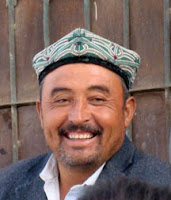Well, I have been a busy bunny this month and have been remiss in reporting my observations from my trip across China!
So here's just a few more pictures from Kashgar.
Kashgar is home to one of the largest statues of Mao Zedong in the world. As you can imagine, in the heart of China's largest autonomous region of predominantly Uyghur people, this statue is not particularly well-loved.
 |
| the massively awkward Chairman towers over Kashgar |
 |
| I know I already posted a picture of this little beauty earlier, but I was just so captivated by her sweet, shy smile! |



















































